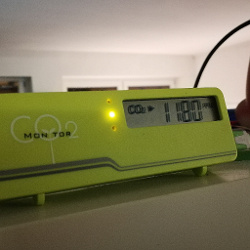Co2 Monitor: Unterschied zwischen den Versionen
| Zeile 13: | Zeile 13: | ||
== Description == | == Description == | ||
| − | Someday a [https:// | + | Someday a [https://amzn.to/2HPV9OG TFA Dostmann CO2-Sensor AirCO2ntrol] appeared in our hackerspace - but the CO² reading couldn't be easily acquired through USB or any other connector. There are some implementations using [https://github.com/fablabnbg/airco2ntrold python] or nodejs, but they require a raspberry pi or at least a PC nearby to read the values to publish and store them somewhere. |
Nowadays ESP8266, NodeMCU or in our case a Wemos D1 mini (which also has a ESP8266 on it) exist and is totally suitable for the job! Sadly, on the TFA Dostmann there's only a USB interface on the outside, and our Microcontroller does not support USB natively. So we opened the sensor and found a "CALIB" interface | Nowadays ESP8266, NodeMCU or in our case a Wemos D1 mini (which also has a ESP8266 on it) exist and is totally suitable for the job! Sadly, on the TFA Dostmann there's only a USB interface on the outside, and our Microcontroller does not support USB natively. So we opened the sensor and found a "CALIB" interface | ||
Version vom 6. September 2019, 12:28 Uhr
| CO² Monitor Status: stable | |
|---|---|

| |
| Beschreibung | IoT CO² Sensor |
| Autor: | schinken |
| PayPal | |
Description
Someday a TFA Dostmann CO2-Sensor AirCO2ntrol appeared in our hackerspace - but the CO² reading couldn't be easily acquired through USB or any other connector. There are some implementations using python or nodejs, but they require a raspberry pi or at least a PC nearby to read the values to publish and store them somewhere.
Nowadays ESP8266, NodeMCU or in our case a Wemos D1 mini (which also has a ESP8266 on it) exist and is totally suitable for the job! Sadly, on the TFA Dostmann there's only a USB interface on the outside, and our Microcontroller does not support USB natively. So we opened the sensor and found a "CALIB" interface
Hardware
Inside the TDA Dostmann CO² sensor, there's a CALIB interface, which consist of four PINs. GND and 5V can easily be determined using a multimeter with continuity test. These PINs are directly connected to the USB port and can be used to power our microcontroller. The other 2 PINs in the middle seem to send some data. After connecting them to a oscilloscope one PIN was obviously just clock, and the other data.
Test readings using SIGROK and a logic analyser can be found on b4ckspace/esp8266-co2monitor/sigrok-captures.
Software
The signals look like they're just I2C, but actually they're not. Using the scope to decode the data failed - the same is true using the Wemos. After wiring up the sensor to the Wemos we used an external interrupt on the clock pin and a digitalRead on the data pin which is basically "bit banging".
The results were promising: Using a simple python script and the documentation from another manufacturer, we were able to verify the checksum. Also implementing the decode of the data was quite simple using the PDF:
case 0x50: co2Measurement = (data[IDX_MSB] << 8) | data[IDX_LSB]; break; case 0x42: temperature = ((data[IDX_MSB] << 8) | data[IDX_LSB]) / 16.0 - 273.15; break;
The last thing to do was connecting to wifi and publishing the data on MQTT. The source code can be found on GitHub and is licensed under the MIT-License.



